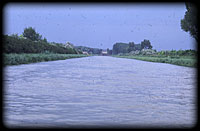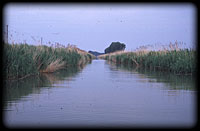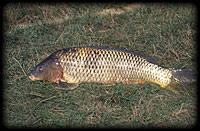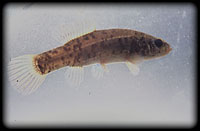 Eastern main channel is the part of a system constructed for lightening water resource management problems of the region beyond the Tisza. The plans of it were ready in the 1930's, its opening in full length however has been done only in 1956. The channel slashing the Great plain in north-south direction, branching out from the Tisza at Tiszalök after going 98 km at Bakonszeg it flows into the Kálló, through which it folws to Hortobágy-Rerettyó, and finally it flows again into the Tisza. As an effect of the Tiszalök barrage the channel gets water by gravity. Maximum permeability of the channel is 60 m3/s, which in consequence of water withdrawals decreases to 15 m3/s at the Kálló spillover. Bed depth varies between 3 and 4 m, its width is 25-30 m. Its vegetation is characterized by shoulder edge plants in its full length, which is dominated by common reed (Phragmites australis), and beside this reed sweet grass (Glyceria maxima), and mainly on the lowland course different bulrush species (Typha angustifolia, T. latifolia, T. laxmannii) are also characteristic species. On the shoulder and in part on the bed slope different rooting and floating waterweed stands are typical, e. g. submerged shoots of yellow water-lily (Nuphar luteum), and common bur-reed (Sparganium erectum), and Loddon pondweed (Potamogeton nodosus), rigid hornwort (Ceratophyllum demersum), frogbit (Hydrocharis morsus-ranae) and great duckweed (Spirodela polyrhiza), the abundance of which increases toward lower courses. Eastern main channel belongs to drinking-water bases of stressed importance. Through the Balmazújváros water withdrawal plant the secound largert city of the country, Debrecen, and many smaller neighbouring settlements get - partly - their drinking-water. From the Eastern main channel in the hight of Tiszavasvári branches the secound most important channel of the Great plain, the Western main channel.
Eastern main channel is the part of a system constructed for lightening water resource management problems of the region beyond the Tisza. The plans of it were ready in the 1930's, its opening in full length however has been done only in 1956. The channel slashing the Great plain in north-south direction, branching out from the Tisza at Tiszalök after going 98 km at Bakonszeg it flows into the Kálló, through which it folws to Hortobágy-Rerettyó, and finally it flows again into the Tisza. As an effect of the Tiszalök barrage the channel gets water by gravity. Maximum permeability of the channel is 60 m3/s, which in consequence of water withdrawals decreases to 15 m3/s at the Kálló spillover. Bed depth varies between 3 and 4 m, its width is 25-30 m. Its vegetation is characterized by shoulder edge plants in its full length, which is dominated by common reed (Phragmites australis), and beside this reed sweet grass (Glyceria maxima), and mainly on the lowland course different bulrush species (Typha angustifolia, T. latifolia, T. laxmannii) are also characteristic species. On the shoulder and in part on the bed slope different rooting and floating waterweed stands are typical, e. g. submerged shoots of yellow water-lily (Nuphar luteum), and common bur-reed (Sparganium erectum), and Loddon pondweed (Potamogeton nodosus), rigid hornwort (Ceratophyllum demersum), frogbit (Hydrocharis morsus-ranae) and great duckweed (Spirodela polyrhiza), the abundance of which increases toward lower courses. Eastern main channel belongs to drinking-water bases of stressed importance. Through the Balmazújváros water withdrawal plant the secound largert city of the country, Debrecen, and many smaller neighbouring settlements get - partly - their drinking-water. From the Eastern main channel in the hight of Tiszavasvári branches the secound most important channel of the Great plain, the Western main channel.
 Total length of the Western main channel is 70 km, it goes in strait line of typical lowland character. Its water output varies between 4 and 12 m3/s. Forming of the channel has been made not simultaneously, so the bed profile differs from
section to section. Width of the bed is 10-25 m depending on the shape. The channel like its larger brother is of upper conduction. Edge vegetation reflects the shape of the bed, it is similar to that described in the Eastern main channel, but it is
generally narrower, and in some places it can be found only in patches. On the bed shoulder and in some places within the bed as well, rooting and floating stands are typical.
Total length of the Western main channel is 70 km, it goes in strait line of typical lowland character. Its water output varies between 4 and 12 m3/s. Forming of the channel has been made not simultaneously, so the bed profile differs from
section to section. Width of the bed is 10-25 m depending on the shape. The channel like its larger brother is of upper conduction. Edge vegetation reflects the shape of the bed, it is similar to that described in the Eastern main channel, but it is
generally narrower, and in some places it can be found only in patches. On the bed shoulder and in some places within the bed as well, rooting and floating stands are typical.
 In the Eastern and Wastern main channels number of fish species is quite high due to the closeness of the Tisza and the excellent water quality, altogether the occurrences of 42 species are known.
In the Eastern and Wastern main channels number of fish species is quite high due to the closeness of the Tisza and the excellent water quality, altogether the occurrences of 42 species are known.
 The full length of the two channels belongs to the level of the common bream (Abramis brama), hence dominant species are coming out among these. In the fish
fauna of the two channels rheophilous and stagnophilous elements also occur in a smaller scale. Fis fauna of the Eastern main channel is more rich, which appears in the presence of species demanding special habitats. Such species are the rheophilous barbel (Barbus barbus), zahrte (Vimba vimba), nose (Chondrostoma
nasus), zingel (Zingel zingel) and Stizostedion volgense, and stagnophilous European mudminnow (Umbra krameri), crucian carp (Carassius
carassius) and mud loach (Misgurnus fossilis). As the home of these species, these water streams - by their balanced hydrobiological relations and good
water quality - can become the refuge also of sensitive species of nature conservation value, which are pushing out from more and more polluted rivers.
The full length of the two channels belongs to the level of the common bream (Abramis brama), hence dominant species are coming out among these. In the fish
fauna of the two channels rheophilous and stagnophilous elements also occur in a smaller scale. Fis fauna of the Eastern main channel is more rich, which appears in the presence of species demanding special habitats. Such species are the rheophilous barbel (Barbus barbus), zahrte (Vimba vimba), nose (Chondrostoma
nasus), zingel (Zingel zingel) and Stizostedion volgense, and stagnophilous European mudminnow (Umbra krameri), crucian carp (Carassius
carassius) and mud loach (Misgurnus fossilis). As the home of these species, these water streams - by their balanced hydrobiological relations and good
water quality - can become the refuge also of sensitive species of nature conservation value, which are pushing out from more and more polluted rivers.
© 1996-2001 TERRA Foundation for Nature Conservation and Education
Last update: Webmaster, 24th October, 2000